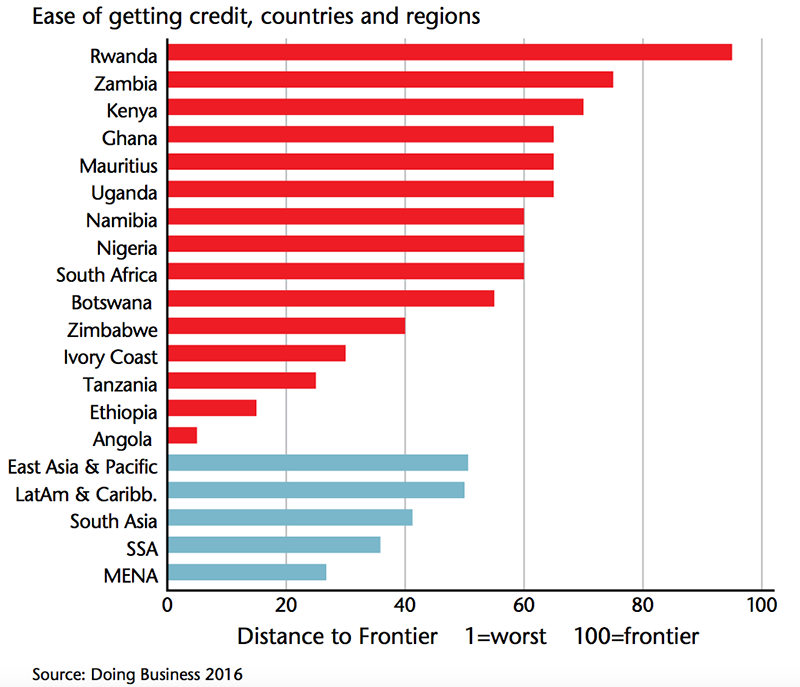A recent economic Insight: Africa Q3 2016, ranked Rwanda as the best country in SSA in terms of getting credit, followed by Zambia, Kenya.
The East African country has made several reforms to facilitate access to credit in the past 6 years thus pushing up its rank.
According to the report, and drawing on insights from World Bank’s Doing Business Rankings, Rwanda performed the best in Sub-Saharan Africa in terms of access to credit. In second place was Zambia followed by Kenya, Ghana, Mauritius, Uganda, Namibia, Nigeria, South Africa, Botswana, Zimbabwe, Ivory Coast, Tanzania, Ethiopia and Angola.

Rwanda’s performance in the doing business rankings in recent years has been exemplary, drawing attention from international observers and investors. Improvements have been made across the board.
In the overall performance, Rwanda is still the best performing country in the East African region as well as 3rd easiest place to do business in Sub-Saharan Africa (1st is Mauritius which ranks 19th globally).
The outlook for economic growth in East Africa remains generally positive, largely because the region’s economies are more diversified than those of the oil- or commodity dependent countries in other regions.
Of 7.3% year-on-year (y-o-y) and 5.9% y-o-y in the first quarter of the year respectively; Uganda recorded a relatively disappointing 3.4% y-o-y rate in the same quarter. Tanzania and Ethiopia have not released any GDP growth figures for this year, but in Ethiopia the growth outlook has deteriorated due to a severe drought.
The report indicates that Southern Africa is going through a difficult time owing to drought-induced problems (higher food prices, strains on hydro-dependent power grids), as well as to anaemic growth in South Africa, the region’s biggest market.
Angola, which came in the bottom of the rankings, has only seen one reform made in the past 6 years regarding access to credit. Furthermore, despite the country having the third largest banking system in Sub Saharan Africa after Nigeria and South Africa, only a small portion of the population is banked and few business apply for loans.
As a whole, Sub Saharan Africa performed relatively poorly compared to other regions in terms of access to credit with a regional average Distance to Frontier (DTF) score of 35.9.
The ICAEW Report also states that there is a large variation in borrowing costs across the continent. Broadly, West African economies face more expensive borrowing costs than East Africa, as authorities try to curtail serious inflation.
This divergence continues when looking at GDP growth in the region. Greater diversification in East Africa should allow stronger economic growth in 2017 and beyond, while the major West African economies continue to suffer the fiscal and monetary consequences of lower oil prices.
The ICAEW report also states that economic risk remains much higher in Africa as a whole compared to other major emerging market regions, but there are a number of bright spots. Botswana, Namibia and Mauritius all fare well by global emerging market risk standards.
The report also shows that East African countries have eased monetary policy over the past year while their West African counterparts tightened it in an effort to slow inflation. The report also shows that Kenya enjoys lower borrowing costs compared to Uganda.





































